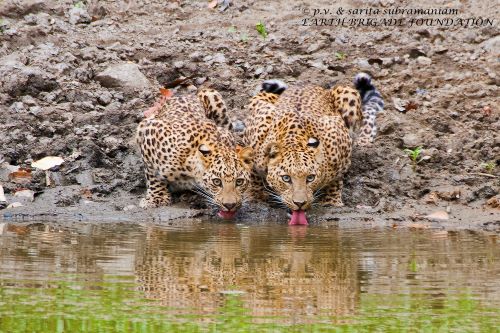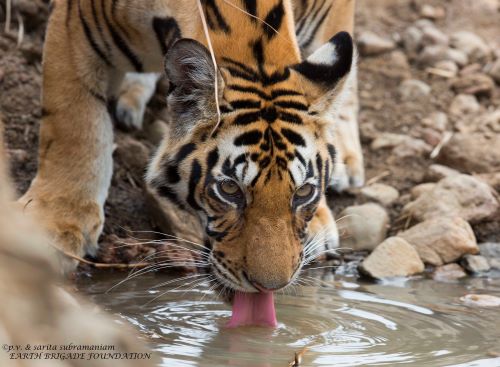By virtue of being on top of the food chain, humans have always been violent against wild animals, wilfully or unknowingly.
Inflicting violence is deeply entrenched in our genes. All our efforts to mask this with a thin veneer of civilization are deceptive, as we regularly indulge in it in myriad forms.
Violence against animals is inherent when they are destined for the table. We are pretty brutal when it comes to food, and this is widely recognized as there has been a spotlight on it in recent times. There have been several initiatives for the humane slaughter of animals for food, as also campaigns by vegan organizations for alternate lifestyles.
Wanton violence against wild animals is one of the most reprehensible, as the victims have no recourse. As the head of a not-for-profit organization called Earth Brigade Foundation that works for wildlife conservation, I am appalled by the frequent, horrific acts of violence against wildlife that humans indulge in.
As the dominant species on this planet, we display utter intolerance towards wildlife when we perceive that it conflicts with our needs and resources, such as land, water, forest produce, etc. As we continue to encroach upon wildlife habitats and use up forest resources for our own needs, wildlife habitats are shrinking and the biodiversity is being eradicated. Grazing of livestock in forests depletes the vegetation meant for wild herbivores, and their population eventually declines. Our fascination for bush meat also depletes animals that are prey for wild predators. This has pushed the population of many predators to the brink.

Our uninhibited agenda for ‘development’ is eating away natural habitats at a frenetic pace, as these are diverted for industrial & infrastructure projects, mining, transport corridors, etc. Afforestation claims by the authorities look good only on paper, as the new saplings planted will never replicate the self-sustaining biodiversity of ancient forests. Every living being in and around and dependent on the tree is affected when a tree is violently cut in the name of ‘development’. We humans don’t see the violent juggernaut we inflict upon wild beings when we inundate swathes of forests to make dams and have river linking projects inside the jungle.
Humans have also exploited ground water resources for their industrial, personal and agricultural needs, which has resulted in a perilous drop in groundwater levels across the country. This also affects wildlife, as it causes the drying-up of water bodies inside the forests. In the summer months, animals that would migrate in search of water and food to different forests now find no water or food inside these forests. They now move towards human settlements in search of water and this results in conflict.

These are inherently acts of violence against wild animals, but not apparent, as we are simply usurping their land, water and food, and sentencing them to slow deaths.
Human-animal conflicts also result in several forms of direct violence towards wildlife:
Poisoning of their drinking water.
Poisoning of their dead prey.
Electrocution, by connecting high-voltage lines to fences.
Beating them to death with sticks or rods.
Lacing their food with explosives, which blow their jaws away.
Crushing them under bulldozers.
Capturing them with snares or traps, in which they often lose both life and limb.
Mutilating the bodies of killed wildlife, like hacking off their limbs or tils, or pulling out their claws, etc.

The perpetrators are not savage mercenaries; they are usually ordinary rural folk living in proximity to forests. They unleash these forms of direct violence against wildlife whenever their interests clash. Local and migrant human populations continue to encroach the forests for settlements or agriculture or to simply exploit the natural resources available in the forests. Cattle/ livestock are even brought from neighbouring villages and sent into the forests for grazing on contract-basis. Poaching of wild animals is done by organized gangs, but with tacit support of the locals, and adds to the list of violent acts against wild wildlife.
If any human life is lost in a wildlife encounter, locals clamour for the immediate removal of the concerned wild animal. While we have strong laws for wildlife conservation, they are rarely implemented as the local vote-banks have power over speechless wild animals.

The conflict reaches a crescendo with the involvement of local and higher politicians. They, in turn, put pressure on the State’s Chief Wildlife Warden, the only Government official in the country who can issue an order to capture or kill highly protected Schedule-1 species like the tiger, leopard or the elephant. Often, in acts of tokenism, any wild animal that is seen in the area later is branded the perpetrator, and either captured alive to be incarcerated, or more often, shot dead. Like a bizzare primitive ritual, the body of the dead predator is even paraded through the local villages.
Stodgy old-time conservationists still proffer the archaic theory of people pleasing to support wildlife conservation, claiming that it is the locals who enable wildlife conservation. The ground reality is different, as the same locals who are supposedly the ‘local stakeholders’ and custodians of this wildlife continue to wantonly maim and kill them.
A recent example is the case of Tigress Avni from Pandharkawada, Yavatmal District, Maharashtra, for whom the Chief Wildlife Warden of Maharashtra issued shoot orders, branding her a ‘man-eater’. The fact that she was a mother nursing two cubs, and likely to be aggressive towards humans venturing too close to her family was ignored. Without clear forensic & DNA evidence, and based purely on circumstantial findings, tigress Avni was still given not one but two, ‘shoot to kill’ orders.
In our fight to save the mother tigress and her cubs, our not-for- profit Earth Brigade Foundation filed three Public Interest Litigations in the Bombay High Court and one in the Supreme Court. Unfortunately, the courts concluded that the Chief Wildlife Warden was empowered to take the decision by law, and dismissed our petitions. Avni was shot dead by a private shikari in November 2018, amidst a slew of violations committed in the operation.
Through our not-for-profit Earth Brigade Foundation, we have tried to mitigate human-wildlife conflict situations through our Project Aquarius: providing drinking water inside the forests by installing solar pumps, which lift groundwater to the surface. Water bodies are replenished using solar energy, and we also use underground pipelines to channelize the water from one pump to multiple sites. This ensures that even smaller animals that cannot travel long distances to one large water-body get access to water, and also improves the biodiversity and creates a self- sustainable ecosystem at each water-body supplied by the solar pump.
This, we believe, is one of the most effective ways of not only helping in wildlife conservation, but also in minimizing human-wildlife conflict and all the attendant violence that goes with it.
Dr. Sarita Subramaniam is a dental surgeon by profession, and a wildlife activist by passion. She has nurtured great fondness for animals since childhood, and now heads her not-for-profit organization called Earth Brigade Foundation, whose primary focus is wildlife conservation. Being an avid bird watcher and nature enthusiast, she has travelled extensively within India, visiting natural habitats and understanding the ground realities. She is deeply concerned about the decimation of wild habitats by human activities, and works towards resolution of man-animal conflict. She has been at the forefront of campaigns to get justice for wronged tigers, such as Ustad of Ranthambore, and Avni of Maharashtra. Her NGO Earth Brigade Foundation provides solar installations to run pumps in forests, bringing drinking water to parched Indian forests. The organization also works for assisting frontline forest staff, as well as for locals involved in conservation work.

Subscribe to our newsletter To Recieve Updates
Join our newsletter to receive updates